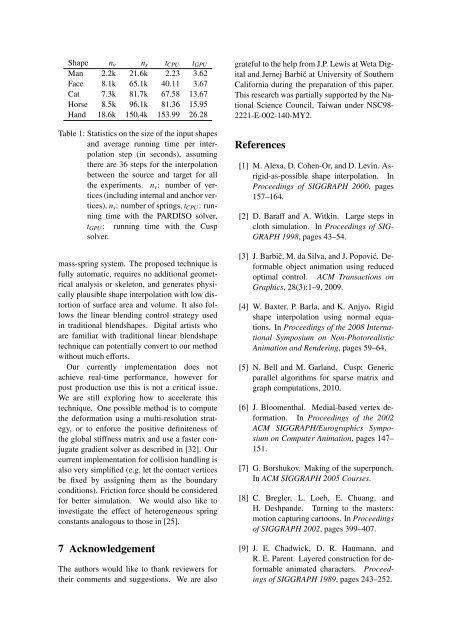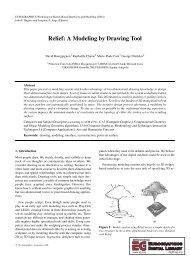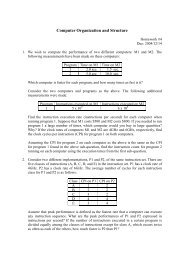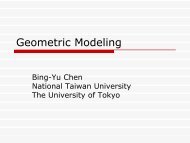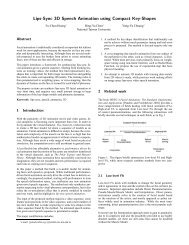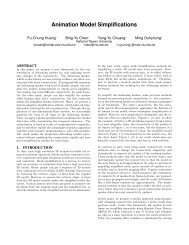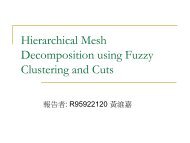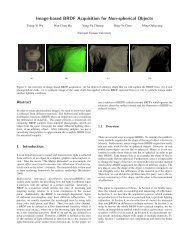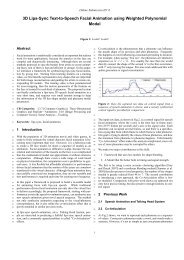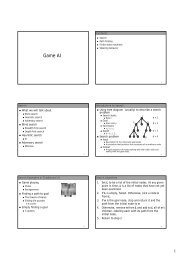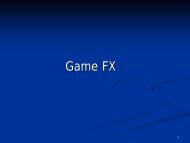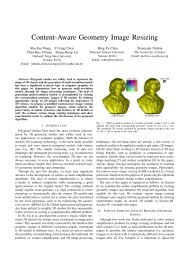A Blendshape Model that Incorporates Physical Interaction
A Blendshape Model that Incorporates Physical Interaction
A Blendshape Model that Incorporates Physical Interaction
- No tags were found...
Create successful ePaper yourself
Turn your PDF publications into a flip-book with our unique Google optimized e-Paper software.
Shape n v n s t CPU t GPUMan 2.2k 21.6k 2.23 3.62Face 8.1k 65.1k 40.11 3.67Cat 7.3k 81.7k 67.58 13.67Horse 8.5k 96.1k 81.36 15.95Hand 18.6k 150.4k 153.99 26.28Table 1: Statistics on the size of the input shapesand average running time per interpolationstep (in seconds), assumingthere are 36 steps for the interpolationbetween the source and target for allthe experiments. n v : number of vertices(including internal and anchor vertices),n s : number of springs, t CPU : runningtime with the PARDISO solver,t GPU : running time with the Cuspsolver.mass-spring system. The proposed technique isfully automatic, requires no additional geometricalanalysis or skeleton, and generates physicallyplausible shape interpolation with low distortionof surface area and volume. It also followsthe linear blending control strategy usedin traditional blendshapes. Digital artists whoare familiar with traditional linear blendshapetechnique can potentially convert to our methodwithout much efforts.Our currently implementation does notachieve real-time performance, however forpost production use this is not a critical issue.We are still exploring how to accelerate thistechnique. One possible method is to computethe deformation using a multi-resolution strategy,or to enforce the positive definiteness ofthe global stiffness matrix and use a faster conjugategradient solver as described in [32]. Ourcurrent implementation for collision handling isalso very simplified (e.g. let the contact verticesbe fixed by assigning them as the boundaryconditions). Friction force should be consideredfor better simulation. We would also like toinvestigate the effect of heterogeneous springconstants analogous to those in [25].7 AcknowledgementThe authors would like to thank reviewers fortheir comments and suggestions. We are alsograteful to the help from J.P. Lewis at Weta Digitaland Jernej Barbič at University of SouthernCalifornia during the preparation of this paper.This research was partially supported by the NationalScience Council, Taiwan under NSC98-2221-E-002-140-MY2.References[1] M. Alexa, D. Cohen-Or, and D. Levin. Asrigid-as-possibleshape interpolation. InProceedings of SIGGRAPH 2000, pages157–164.[2] D. Baraff and A. Witkin. Large steps incloth simulation. In Proceedings of SIG-GRAPH 1998, pages 43–54.[3] J. Barbič, M. da Silva, and J. Popović. Deformableobject animation using reducedoptimal control. ACM Transactions onGraphics, 28(3):1–9, 2009.[4] W. Baxter, P. Barla, and K. Anjyo. Rigidshape interpolation using normal equations.In Proceedings of the 2008 InternationalSymposium on Non-PhotorealisticAnimation and Rendering, pages 59–64.[5] N. Bell and M. Garland. Cusp: Genericparallel algorithms for sparse matrix andgraph computations, 2010.[6] J. Bloomenthal. Medial-based vertex deformation.In Proceedings of the 2002ACM SIGGRAPH/Eurographics Symposiumon Computer Animation, pages 147–151.[7] G. Borshukov. Making of the superpunch.In ACM SIGGRAPH 2005 Courses.[8] C. Bregler, L. Loeb, E. Chuang, andH. Deshpande. Turning to the masters:motion capturing cartoons. In Proceedingsof SIGGRAPH 2002, pages 399–407.[9] J. E. Chadwick, D. R. Haumann, andR. E. Parent. Layered construction for deformableanimated characters. Proceedingsof SIGGRAPH 1989, pages 243–252.


